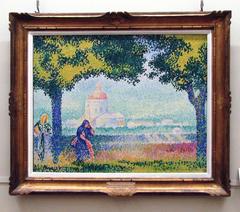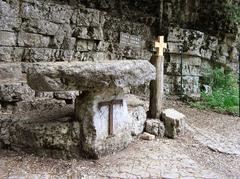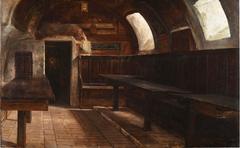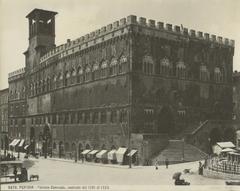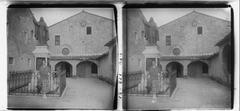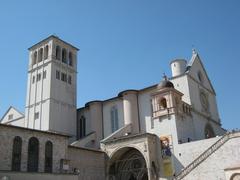Comprehensive Guide to Visiting Basilica di Santa Chiara, Assisi, Italy
Date: 17/07/2024
Introduction
The Basilica di Santa Chiara in Assisi, Italy, is a captivating historical and religious landmark attracting thousands of visitors annually. Constructed between 1257 and 1265, shortly after the canonization of Saint Clare of Assisi, the basilica stands as a testament to her legacy and the Franciscan movement (Assisi Online). Saint Clare, a noblewoman who renounced her wealth to follow Saint Francis, founded the Order of Poor Ladies, later known as the Poor Clares. The basilica, built to honor her and house her remains, is a masterpiece of Umbrian Gothic architecture, characterized by its simplicity and austerity, reflecting the values of the Franciscan order (Sacred Destinations). From the pink and white stone facade sourced from Mount Subasio to the large rose window and bell tower, every feature of the basilica exudes historical and spiritual significance.
Table of Contents
- [Introduction](#introductionintroduction)
- [History](#historyhistory)
- [Origins and Construction](#origins-and-constructionorigins-and-construction)
- [Saint Clare and the Poor Clares](#saint-clare-and-the-poor-claressaint-clare-and-the-poor-clares)
- [Architectural Features](#architectural-featuresarchitectural-features)
- [Rose Window](#rose-windowrose-window)
- [Bell Tower](#bell-towerbell-tower)
- [Historical Significance](#historical-significancehistorical-significance)
- [Art and Relics](#art-and-relicsart-and-relics)
- [Crucifix of San Damiano](#crucifix-of-san-damianocrucifix-of-san-damiano)
- [Frescoes](#frescoesfrescoes)
- [Tomb of Saint Clare](#tomb-of-saint-claretomb-of-saint-clare)
- [Influence on Franciscan Architecture](#influence-on-franciscan-architectureinfluence-on-franciscan-architecture)
- [Practical Visitor Information](#practical-visitor-informationpractical-visitor-information)
- [Visiting Hours and Tickets](#visiting-hours-and-ticketsvisiting-hours-and-tickets)
- [Travel Tips](#travel-tipstravel-tips)
- [Special Events and Guided Tours](#special-events-and-guided-toursspecial-events-and-guided-tours)
- [Preservation and Restoration](#preservation-and-restorationpreservation-and-restoration)
- [Frequently Asked Questions (FAQ)](#frequently-asked-questions-faqfrequently-asked-questions-faq)
- [Conclusion](#conclusionconclusion)
- [References](#referencesreferences)
History
Origins and Construction
The Basilica di Santa Chiara, located in Assisi, Italy, is a significant religious site with a rich history dating back to the 13th century. The basilica was constructed between 1257 and 1265, shortly after the canonization of Saint Clare of Assisi in 1255. Saint Clare, a follower of Saint Francis of Assisi, founded the Order of Poor Ladies, later known as the Poor Clares. The basilica was built to honor her and house her remains. The architectural design of the basilica is attributed to the Umbrian Gothic style, characterized by its simplicity and austerity, reflecting the values of the Franciscan order.
Saint Clare and the Poor Clares
Saint Clare of Assisi, born Chiara Offreduccio in 1194, was a noblewoman who renounced her wealth to follow the teachings of Saint Francis. In 1212, she founded the Order of Poor Ladies, which later became known as the Poor Clares. The order was dedicated to a life of poverty, prayer, and service. Saint Clare’s commitment to these principles was unwavering, and she became a revered figure in the Christian community. The basilica was constructed to serve as the mother church for the Poor Clares and to enshrine the remains of Saint Clare. Her body was initially buried in the Church of San Giorgio but was later transferred to the newly built basilica in 1260. The crypt, where her remains are housed, was discovered in 1850 and has since become a focal point for pilgrims and visitors (Catholic Encyclopedia).
Architectural Features
Rose Window
One of the most striking features of the basilica is the large rose window on the facade, which allows natural light to illuminate the interior. This architectural element is a hallmark of Gothic design, symbolizing divine illumination and spiritual insight.
Bell Tower
The bell tower, added in the 14th century, stands as a testament to the basilica’s enduring significance. The simplicity of the design, combined with the use of local materials, reflects the Franciscan ideals of humility and devotion.
Historical Significance
The Basilica di Santa Chiara holds immense historical significance, not only as a religious site but also as a symbol of the Franciscan movement. The basilica has been a place of pilgrimage for centuries, attracting visitors from around the world who seek to connect with the legacy of Saint Clare and the Franciscan order. Throughout its history, the basilica has witnessed numerous events and transformations. During the 14th and 15th centuries, it underwent several renovations and expansions to accommodate the growing number of pilgrims. The basilica also played a crucial role during the Italian Wars of the 16th century, serving as a refuge for the local population. In the modern era, the basilica continues to be a vibrant center of worship and cultural heritage. It has been recognized as a UNESCO World Heritage Site, along with other Franciscan sites in Assisi, highlighting its global importance. The basilica’s preservation and restoration efforts ensure that future generations can appreciate its historical and spiritual significance (UNESCO).
Art and Relics
Crucifix of San Damiano
The basilica houses the famous crucifix of San Damiano, believed to have spoken to Saint Francis, urging him to ‘rebuild my church.’ This crucifix is displayed in a chapel within the basilica, attracting numerous visitors and devotees.
Frescoes
The interior walls of the basilica are adorned with frescoes that are masterpieces of medieval art. These frescoes, created by various artists over the centuries, depict scenes from the lives of Saint Clare and Saint Francis, as well as other biblical narratives. The artworks provide valuable insights into the religious and cultural context of the time.
Tomb of Saint Clare
The basilica also houses the tomb of Saint Clare, located in the crypt. The tomb is a place of veneration and prayer, drawing pilgrims who seek spiritual solace and inspiration. The crypt also contains other relics associated with Saint Clare and the early members of the Poor Clares (Italy Magazine).
Influence on Franciscan Architecture
The Basilica di Santa Chiara has had a profound influence on the development of Franciscan architecture. Its design and construction set a precedent for other Franciscan churches and monasteries across Europe. The emphasis on simplicity, use of local materials, and integration of natural light became defining features of Franciscan architectural style. The basilica’s architectural elements, such as the rose window, bell tower, and frescoes, have been emulated in various religious buildings. The principles of humility and devotion embodied in the basilica’s design continue to inspire contemporary architects and builders (Britannica).
Practical Visitor Information
Visiting Hours and Tickets
The Basilica di Santa Chiara is open to visitors throughout the year, but the visiting hours may vary depending on the season. Generally, the basilica is open from 6:30 AM to 12:00 PM and from 2:00 PM to 7:00 PM. It is advisable to check the official website or contact the basilica directly for the most up-to-date information on visiting hours. Admission to the basilica is free, but donations are welcome to support the ongoing preservation and maintenance efforts. Guided tours are available for a fee, providing visitors with deeper insights into the history, architecture, and significance of the basilica.
Travel Tips
- Getting There: Assisi is well-connected by train and bus services from major Italian cities like Rome and Florence. The basilica is located within walking distance from the town center.
- Best Time to Visit: The best time to visit the Basilica di Santa Chiara is during the spring and fall months when the weather is pleasant, and the crowds are smaller.
- Nearby Attractions: Other notable sites in Assisi include the Basilica of Saint Francis, the Church of San Damiano, and the Rocca Maggiore fortress.
- Accessibility: The basilica is accessible to visitors with disabilities, with ramps and elevators available for easy access to different sections.
Special Events and Guided Tours
Throughout the year, the Basilica di Santa Chiara hosts special events, religious ceremonies, and festivals that attract numerous visitors. These events offer a unique opportunity to experience the basilica’s spiritual ambiance and cultural heritage. Guided tours are available in multiple languages and provide an in-depth understanding of the basilica’s history, architecture, and artistic treasures. Booking a guided tour in advance is recommended, especially during peak tourist seasons.
Preservation and Restoration
Over the centuries, the Basilica di Santa Chiara has undergone numerous preservation and restoration efforts to maintain its structural integrity and historical authenticity. These efforts have been crucial in safeguarding the basilica’s architectural and artistic heritage. In the 19th and 20th centuries, extensive restoration work was carried out to address issues such as structural damage, weathering, and deterioration of frescoes. Modern conservation techniques have been employed to ensure that the basilica remains a vibrant and accessible site for worship and tourism. The ongoing preservation efforts are supported by various organizations, including the Italian government, religious institutions, and international heritage bodies. These collaborative efforts aim to protect the basilica’s historical and cultural significance for future generations (Assisi Tourism).
Frequently Asked Questions (FAQ)
Q: What are the visiting hours for the Basilica di Santa Chiara?
A: The basilica is generally open from 6:30 AM to 12:00 PM and from 2:00 PM to 7:00 PM. It is advisable to check the official website for the most up-to-date information on visiting hours.
Q: Is there an entry fee for the Basilica di Santa Chiara?
A: Admission to the basilica is free, but donations are welcome to support preservation efforts.
Q: Can I take a guided tour of the Basilica di Santa Chiara?
A: Yes, guided tours are available for a fee and provide valuable insights into the basilica’s history and significance.
Q: What are the best times to visit the Basilica di Santa Chiara?
A: The best times to visit are during the spring and fall months when the weather is pleasant, and the crowds are smaller.
Conclusion
The Basilica di Santa Chiara is a remarkable historical and religious site that embodies the legacy of Saint Clare and the Franciscan movement. Its architectural features, historical significance, and cultural heritage make it a must-visit destination for pilgrims and tourists alike. Whether you are drawn by its rich history, stunning architecture, or spiritual ambiance, the basilica offers a unique and enriching experience. With practical visitor information, travel tips, and insights into its preservation efforts, this guide ensures that you can make the most of your visit. The basilica’s enduring appeal and influence continue to inspire and captivate visitors from around the world, making it an essential stop in any Assisi itinerary (UNESCO, Assisi Tourism).
References
- Assisi Online, 2023, source
- Sacred Destinations, 2023, source
- Catholic Encyclopedia, 2023, source
- UNESCO, 2023, source
- Italy Magazine, 2023, source
- Britannica, 2023, source
- Franciscan Media, 2023, source
- Catholic News Agency, 2023, source
- Great Buildings, 2023, source
- Structurae, 2023, source
- Assisi Guide, 2023, source
- Visit Assisi, 2023, source
- Italy Rail, 2023, source
- Basilica di Santa Chiara Official Site, 2023, source

